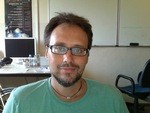Previous events - Page 221
Andreas Andersson (UiO): An introduction to duality for compact groups in algebraic quantum field theory
Tamara Broderick (Massachusetts Institute of Technology) will give a seminar in the lunch area, 8th floor Niels Henrik Abels hus at 14:15.
Late Lunch Talk by Joost Raeymaekers, Centre for Biodiversity Dynamics, NTNU
In this talk, we will present some applications of the "transfer" to
algebraic K-theory, inspired by the work of Thomason. Let A --> B be a
G-Galois extension of rings, or more generally of E-infinity ring spectra
in the sense of Rognes. A basic question in algebraic K-theory asks how
close the map K(A) --> K(B)^hG is to being an equivalence, i.e., how close
K is to satisfying Galois descent. Motivated by the classical descent
theorem of Thomason, one also expects such a result after "periodic"
localization. We formulate and prove a general lemma that enables one to
translate rational descent statements as above into descent statements
after telescopic localization. As a result, we prove various descent
results in the telescopically localized K-theory, TC, etc. of ring
spectra, and verify several cases of a conjecture of Ausoni-Rognes. This
is joint work with Dustin Clausen, Niko Naumann, and Justin Noel.
Movement Resistant Orientation Selective Neurons in the Deeper Layers of the Rat Primary Visual Cortex
Morten Bo Madsen, Associate Professor, Astrophysics and Planetary Science, Niels Bohr Institute
In many harvested ecosystems, laws and regulations protect animals below a certain size from being killed. However, in species such as fish, it is often the large, old animals that represent the reproductive capital of a population, and that might need protection even more.
Late Lunch Talk by Malin Pinsky, Rutgers University, USA
The Bass-Quillen conjecture states that every vector bundle over A^n_R is
extended from Spec(R) for a regular noetherian ring R. In 1981, Lindel
proved that this conjecture has an affirmative solution when R is
essentially of finite type over a field. We will discuss an equivariant
version of this conjecture for the action of a reductive group. When R =
C, this is called the equivariant Serre problem and has been studied by
authors like Knop, Kraft-Schwarz, Masuda-Moser-Jauslin-Petrie. In this
talk, we will be interested in the case when R is a more general regular
ring. This is based on joint work with Amalendu Krishna
Mohammad Koochak Zadeh at the Department of Geosciences will be defending his dissertation: Compaction and rock properties of siliciclastic sediments- Implications for reservoir characterization, velocity anisotropy and buildup of abnormal pore pressure
Michal Michalowski, Royal Observatory Edinburgh, School of Physics and Astronomy, The University of Edinburgh
Enrico Fermi and the birth of modern nonlinear physics
In the early fifties in Los Alamos E. Fermi in collaboration with J. Pasta and S. Ulam investigated a one dimensional chain of equal masses connected by a weakly nonlinear spring. The key question was related to the understanding of the phenomenon of conduction in solids; in particular they wanted to estimate the time needed to reach a statistical equilibrium state characterized by the equipartition of energy among the Fourier modes. They approached the problem numerically using the MANIAC I computer; however, the system did not thermailize and they observed a recurrence to the initial state (this is known as the FPU-recurrence). This unexpected result has led to the development of the modern nonlinear physics (discovery of solitons and integrability). In this seminar, I will give an historical overview of the subject and present the different approaches that have been proposed in the last 60 years for explaining this paradox. Very recent results on the estimation of the time scale and on the explanation of the mechanism of equipartition will also be discussed.
This Friday the journal club will discuss a paper by Gene Hunt and Graham Slater (2016): "Integrating Paleontological and Phylogenetic Approaches to Macroevolution" .
Join us!
Doctoral candidate Mohammad Koochak Zadeh at the Department of Geosciences will give a trial lecture on the given topic: The application of rock physics in 4D seismic interpretation
Adaptive response in cancer cells to long-term tankyrase inhibitor treatment
In Part 2 we will delve into the worlds of derived and spectral algebraic
geometry. After reviewing some basic notions we will explain how motivic
homotopy theory can be extended to these settings. As far as time permits
we will then discuss applications to virtual fundamental classes, as well
as a new cohomology theory for commutative ring spectra, a brave new
analogue of Weibel's KH
In Part 2 we will delve into the worlds of derived and spectral algebraic
geometry. After reviewing some basic notions we will explain how motivic
homotopy theory can be extended to these settings. As far as time permits
we will then discuss applications to virtual fundamental classes, as well
as a new cohomology theory for commutative ring spectra, a brave new
analogue of Weibel's KH
Johanne Hope Rydsaa at the Department of Geosciences will be defending her dissertation: On biosphere-atmosphere interactions in a changing climate
Anastasia Sokolenko, FI
In this work we propose a new interesting channel for searching new physics at the LHC. This channel is connected to the diphoton channel via electroweak gauge symmetry of the Standard Model (SM). We discuss the possibility that an apparent diphoton signal is in fact produced by the 4-photon channel, where a pair of collimated photons is misidentified as 1 photon due to finite angular resolution of the detector. In this case we expect that the gauge symmetry of the SM connects the diphoton channel to three boson channels. Also we notice that the same mechanism could give an experimental signature of $Z\rightarrow \gamma\gamma$ decay, which is theoretically forbidden by the Landau-Yang theorem. For definiteness we illustrate these ideas using one of the models that was discussed to explain the recent 750 GeV resonance, even if the later signal was not confirmed.
(The slides will be available here)
"Habitat selection in Paridae and possible impacts by forestry”
Doctoral candidate Johanne Hope Rydsaa at the Department of Geosciences will give a trial lecture on the given topic: Biogenic Secondary Organic Aerosols (BSOA): sources, processes and climate impacts
UiO:Life Science will fund several «konvergensmiljø» – research groups with collaboration across conventional disciplinary boundaries. The application process starts with workshops with speed dating September 28 and 29.
Late Lunch Talk by Meike Wortel, CEES
Jens Paaske, NBI Copenhagen
Motivated by recent experiments, we study lattices of magnetic adatoms exchange coupled to the surface of a conventional s-wave superconductor. We show that a variety of collective magnetic and electronic phases emerge in this system, due to the interplay between ferromagnetism and superconductivity. In particular, an adatom chain on a bulk (2d or 3d) superconductor can order into a magnetic spiral state leading to, and stabilized by, the opening of a topological superconducting gap within the band of YSR states induced by the adatoms. The spiral wave-vector increases sharply as the YSR energy is lowered from the quasiparticle continuum, due to a strong spin-spin exchange interaction mediated through the band of sub-gap YSR states. As the YSR band enters the topological phase, the wave-vector exhibits a peak and is thereafter driven down towards ferromagnetism due to YSR state double-exchange. We provide the range of YSR energies and adatom spacing where these phases exist for adatoms on a 3d, or 2d superconductor. The magnetic ordering within a 2d YSR lattice is also explored.(The slides will be available here)



